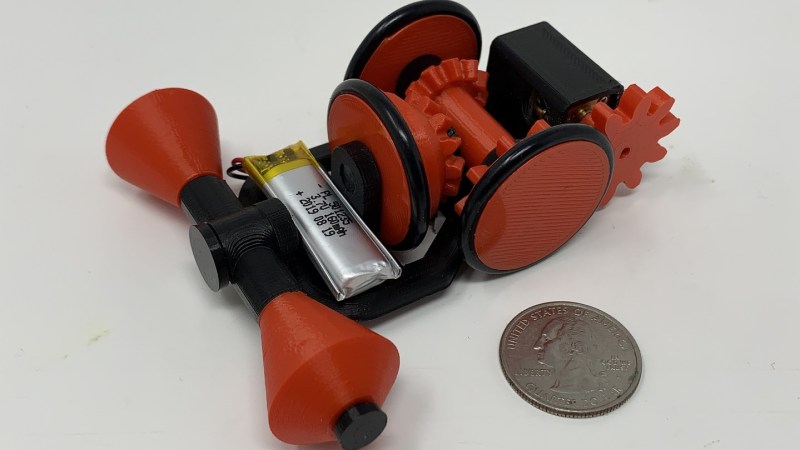In the age of cheap sensors and microcontrollers, it’s easy to forget that there might be very simple mechanical solutions to a problem. [gzumwalt]’s 3D printed mechanical edge avoiding robot is a beautifully elegant example of this.
The only electric components on this robot is a small geared DC motor and a LiPo battery. The motor drives a shaft fixed to a wheel on one side, while the opposite wheel is free-spinning. A third wheel is mounted perpendicular to the other two in the center of the robot, and is driven from the shaft by a bevel gear. The third wheel is lifted off the surface by a pair of conical wheels on a pivoting axle. When one of these conical wheels go over the edge of whatever surface it’s driving on, it lowers front and brings the third wheel into contact with the surface, spinning the robot around until both front wheels are back on the surface.
Mechanical alternatives for electronic systems are easily overlooked, but are often more reliable and rugged in hostile environments. NASA is looking at sending a rover to Venus, but with surface temperatures in excess of 450 °C and atmospheric pressure 92 times that of Earth, conventional electronics won’t survive. Earlier in the year NASA ran a design competition for a completely mechanical obstacle detection system for use on Venus.
[gzumwalt] is a very prolific designer on ingenious 3D printed mechanical devices. This mechanism could also be integrated in his walking fridge rover to explore the front of your fridge without falling off.
















gzumwalt’s work is always fireeee. From his desktop illusions to illusions to the fact that he’s posting alot of his projects here on hackaday.io, he’s a treasure trove of inspiration!
One seriously awesome dude.
I had a toy from W. Germany that worked like this in the 1960’s. A tiny mercedes wind up toy using the same principles. Schuco?
I think the essentials are known from late Victorian steam age tech, used in pattern followers or self centering devices.
I had this article’s design (more or less) turn up in my Christmas stocking a few years ago – may still have it somewhere.
Very well done
Pretty sure we know a lot more about the surface of the ocean than we do of Venus.
Good work, but not a new idea. https://www.youtube.com/watch?v=rZ3p_d4ZxtM
Well spotted.
You know besides War, Space is one of the biggest drivers of technological advancement there is. And honestly I would rather the cutting edge being used to learn and explore rather than finding new and better ways of blowing people up.
So much stuff was born from Space, small computers, advanced composites, friction stir welding, the list just goes on and on and on.
Yet at the end of the day it’s just an excuse – or worse, it’s a gamble. You set up a challenge, but you can’t predict or design what technologies will come out of it, if any, so it’s always a question of justifying the spending retroactively.
In other words, we might throw the money down just any other well, and if it happens to produce anything of worth, we can always use that to justify throwing money down any other well. By that token, I just won big time in Las Vegas, anyone up for another trip? C’mon, by my past record it’s a good investment!
Never seen this design before. Very neat!
That’s nice, but you censored the comments relating to NASA and the Venus rover, so what are we supposed to do here then?
It would be very helpful if you would specify at the end of the article what opinions and points of view are allowed, so we could avoid wasting time.
If it helps, history tells us that approximately 8 out of 10 of your “points” are a waste of time.
If we go by those odds, then the comment should have stayed because I was disagreeing with it.
Great ! But cannot really see the third wheel mentioned there : “brings the third wheel into contact with the surface” or did I miss something ?
Does the car avoid falls only in the clockwise direction? Or is there a mechanism to reverse the spin of the correcting wheel? Or maybe it just forces the whole car back into clockwise motion dragging both front wheels across?
I guess the correction wheel pivots over to be driven by the gear on the other side –
Gzumwalt designs the most incredible 3D printed mechanisms ever! This one is easy to print and fun to watch.